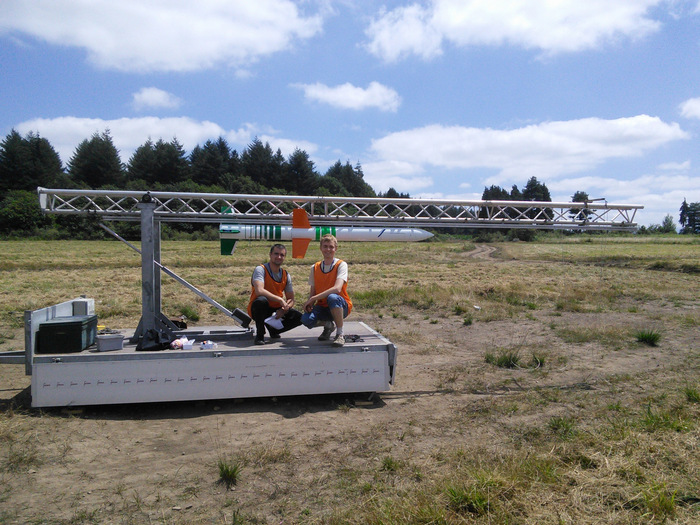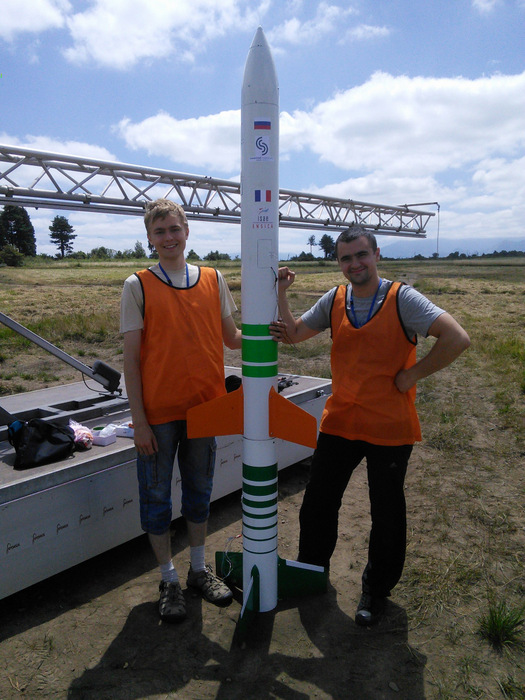Samara University students successfully launched the experimental rocket TSR 1.1 from a French military proving ground near the Town of Tarbes. The launch was part of the International Student Forum C’Space, dedicated to the development of university activities in designing small rockets and atmospheric sounders.
This year, 29 teams took part in the Forum: two of them were from Japan, one was from Austria, one team was from Russia. Other participants represented various French cities. On the whole, 350 young scientists came to the Forum.
As reported by members of the Samara University team, Jean-Maurice Ripert, French Ambassador to Russia, was present at the launch of their rocket. He spoke to the team before the start and wished the guys luck. As you may recall, last May, Mr. Ripert visited Samara University and met the students. Besides the French Ambassador to Russia, French generals and employees of the French space agency CNES were present at the launch.
“The start was stressful, there were lots of guests of honour on the ground, and we were the only team from Russia. It is a great responsibility. The tension broke as soon as I pressed the launch button and the rocket rushed up like a lightning bolt with a deafening roar, but that was only half the job done. When I saw the rocket stages coming down on parachutes and CanSats, I realized that we had managed to do it. Everyone applauded and congratulated us,” said Alexey Baturin, a team member, sharing his impressions of the first launch of their own experimental rocket.
Samara University students successfully launched a two-stage rocket at C’Space, its length is 2.5 meters, its diameter is 16 cm, there were three CanSat atmospheric sounders, parachutes, engines and various electronics inside it. This year, the students’ efforts were directed towards improvement of the rocket’s reliability and advancement of the rescue system. The sounders launched by the Samara rocket were made as part of a joint project between Samara University students and the Toulouse Space Aeronautics Institute ISAE-Supaero.
“We tried to improve the parachute system in our experimental model and check it up as well as test the CanSat discharge system, and we fulfilled these tasks completely. Thanks to this launch, we determined the most effective position of parachute systems in a rocket and the CanSat discharge system, testing our hypothesis in practice,” Andrey Chernyaev, a team member, said.
Evaluating the significance of the event, Alexey Baturin said: “The experience of taking part in the C’Space Forum is invaluable for me. I had a lot of productive talks with foreign colleagues, discussing all of the issues associated with the launch, and I got the opportunity to establish contacts that will help me in my future research work. I learned to work as part of a team. I learned new technical solutions that I’ll be able to use in future. In particular, there were interesting rocket models made from carbon, and I was also interested in the pump joint system for linking up stages and other solutions. And the most important thing is that taking part in the Forum helps you feel that dreams about space are becoming a little bit closer to reality.”
The International Forum C’Space ended on July 30.
Information
Since 2011, SSAU – Samara State Aerospace University (now Samara University) – has been regularly participating in the International Student Forum C’Space, dedicated to the launching of experimental rockets, which originally took place in France in the Town of Biscarrosse, while the Town of Tarbes has been the venue since 2015. The Samara University team is the only team that represented Russia. The launch of the first rocket, an exact copy of the carrier rocket “Soyuz-2,” was timed to coincide with the first launch of the original carrier rocket designed at the Samara Rocket and Space Center, from the Kourou space-vehicle launching site (French Guiana).
Models of carrier rocket “Soyuz-2” were made every year, employing the resources and capacities of Samara Design Bureau-4 (SDB-4). Every year the construction advanced, new systems and detectors appeared, and the mechanical part became more sophisticated. Thus, for example, the possibility of discharging an atmospheric sounder, the so-called CanSat, appeared in 2013.
In 2014, a model of carrier rocket “Soyuz-5” was developed at SDB-4 (A. Kvetkin, I. Kiselev). This rocket brought three atmospheric sounders to an altitude of approximately 700 meters – two of them were made by ISAE-Supaero students.
In 2015, an original model of a two-stage rocket brought three atmospheric sounders to an altitude of approximately 1,200 m.






